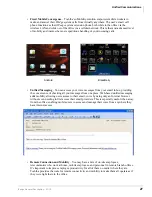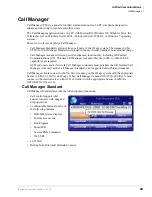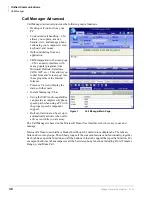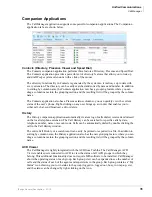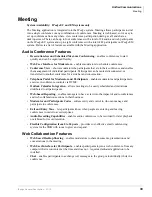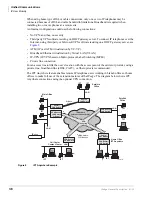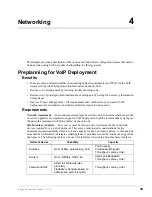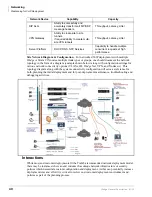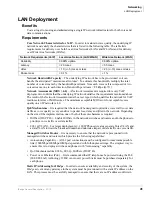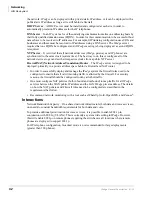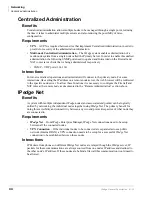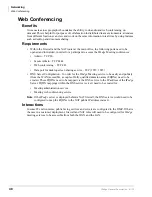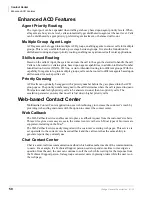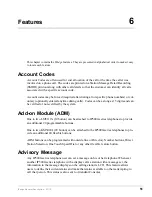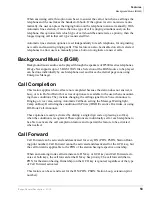
Networking
LAN Deployment
IPedge General Description 01/12
41
LAN Deployment
Benefits
Cost savings from using and administering a single IP network infrastructure for both voice and
data communications.
Requirements
Core Network Characteristics for VoIP
– In order to maintain voice quality, the underlying IP
network must satisfy the characteristics that are listed in the following table. The table lists
requirements for delivery over both Local Area Networks (LANs and WLANs) and for delivery
over Wide Area Networks (WANs).
Network Bandwidth Capacity
– The underlying IP network has to be provisioned so it can
handle the anticipated “maximum call volume”. To estimate this bandwidth, multiply the total
number of voice streams by the bandwidth per stream. Note each voice call is composed of two
voice streams, one in each direction. Bandwidth per stream = 88 kbps (G.711)
Network Assessments (MOS > 4.0)
– A Network Assessment is required for every VoIP
deployment to confirm that the underlying IP network satisfies the requirement mentioned above.
The result of the Network Assessment must be a test report which qualifies the network for VoIP
readiness in terms of MOS scores. The minimum acceptable MOS score for acceptable voice
quality on an IP network is 4.0.
QoS Mechanisms
– It is required that the network be designed to prioritize voice traffic over data
traffic as voice quality is very sensitive to packet loss, delay and jitter in the network. Depending
on the size of the implementation, one or both of these mechanisms is required.
•
DiffServ (DSCP 46) – Enable DiffServ in the network switches and routers and in the phones to
prioritize voice traffic over data traffic.
•
802.1q (VLAN) – For larger deployments (> 100 IP Phones) create a separate Voice VLAN and
a data VLAN to limit the broadcast domain and minimize impact of data traffic on voice traffic.
Managed Switch or Router
– It is necessary to ensure that the network is provisioned with
managed switches and routers which provide the following capabilities:
•
Autosensing Capability – All L2 port connections must be configured for maximum possible
link (1000Mbps/100Mbps/10Mbps) speed and with full-duplex settings. The simplest way to
ensure this is to deploy switches and phones with “Autosensing” capability.
•
QoS Mechanisms like 802.1q, 802.1p, DiffServ (DSCP 46)
•
Power over Ethernet (PoE) – It is recommended that IP telephones be powered using the PoE
(IEEE 802.3af) technology. If PoE is not used, power bricks must be purchased separately for
each phone.
Static IP Addressing for IP
edge
– In order to ensure availability and security of the system, the
IP
edge
server and any gateways in the system must be provisioned with a static IP address on the
LAN. This process must be carefully managed to ensure that there are no IP address conflicts in
Network Requirements (VoIP)
Local Area Network (LAN/WLAN)
Wide Area Network (WAN)
Reliability
99.99% uptime
99.99% uptime
Latency
< 20 msec
< 50 msec
Jitter
< 10 (+/- 5) msec or less
< 20 (+/-10) msec or less
Packet Loss
< 0.1%
< 1%
Содержание ID EDGE
Страница 1: ...TOSHIBA Telecommunication Systems Division January 2012 General Description Title Page ...
Страница 6: ...This page is intentionally left blank ...
Страница 12: ...This page is intentionally left blank ...
Страница 24: ...This page is intentionally left blank ...
Страница 128: ...This page is intentionally left blank ...
Страница 134: ...This page is intentionally left blank ...
Страница 142: ...This is the last page of the document ...

